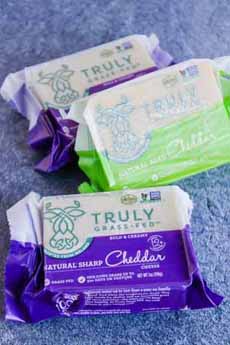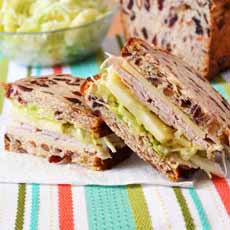TOP PICK OF THE WEEK: Truly Grass-Fed Cheddar
|
We have our favorite cheddar cheeses: artisan wonders like Beehive Cheddar from Utah, Cabot Clothbound Cheddar from Vermont, and Fiscalini Farmstead Cheddar from California. Our favorite “supermarket cheddar”—the 7- or 8-ounce prepacked bars found in supermarket refrigerator cases—is Cabot Cheddar, available in some 30 varieties including flavors we love, like Hot Jalapeño, Habanero, Horseradish and Tomato Basil. As we have lactose sensitivity, we enjoy a lot of cheddar, which is 100% lactose free (along with Jarlsberg). When we agreed to receive samples of Truly Grass-Fed Cheddar, we thought it was a domestic product. Turns out, it’s from Ireland. No wonder it tastes so special for a supermarket cheese. We find it more nuanced and elegant than our go-to Cabot line. It’s not anywhere as easy to find as Cabot, but if you come across it, bring it home! (Here’s a store locator; and you can find the cheese online at Amazon.) Why the lovely flavor? Cows that feed on lush pasture produce tastier milk. It’s that simple. (The milk is also more nutritious—more about that below). The milk for Truly Grass Fed cheddar comes from approximately 3,000 family farms located across Ireland. Our farmers share deep bonds with their herds, with sustainability and animal welfare always top of mind. Each farm has an average of one cow for every two acres of pasture, is Certified Animal Welfare Approved by A Greener World. AWA is an independent nonprofit farm-certification program, which guarantees that animals are raised outdoors on pasture on independent farms their entire lives, using truly sustainable, high welfare farming practices. And that’s why Truly Grass-Fed cheddars are creamy and delicious: made from the wholesome milk of cows living their best lives outside, grazing on plentiful green grass. The cows receive 95% of their nutritional feed from grass. They are grazed in fields for up to 300 days a year. Cold weather sends them indoors for a couple of months, where they continue on a grass silage* diet with some limited supplementation. They are: What’s the big deal with grass-fed milk products? Studies show that the nutritional quality of milk is superior from cows that are grass fed, as nature intended them to be, versus those that are grain fed. |
|
|
|
Key nutritional elements include: Grass-fed cows eat (mostly) grass, their natural diet; while grain-fed cows eat (mostly) an unnatural diet based on corn and soy. If you were a cow, which would you prefer? ________________ *Silage is grass or other green fodder compacted and stored in airtight conditions, used as animal feed in the winter. It is typically stored in a silo; hence, silage. Hay is grass that is dried first. †Cheddars that are orange are colored with a natural vegetable dye, annatto.
|
||





